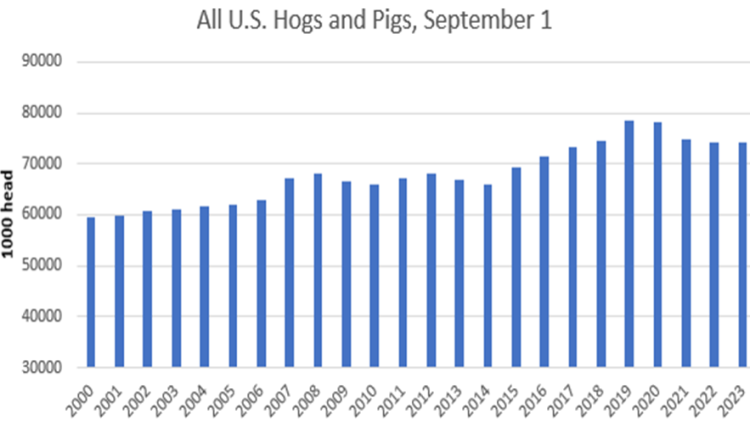Non-urgent government operations are closed December 24 to January 1, reopening January 2. View available services during this period.
See event listing and more articles
See event listings and more articles in this edition of Agri-News: October 10, 2023 issue
The USDA Quarterly Hogs and Pigs report was released by the National Agricultural Statistics Service on September 28, 2023. Overall, estimates were higher than expected for all categories, except for farrowings. Inventory of all U.S. hogs and pigs on September 1, 2023 was estimated at 74.3 million head, up 0.3% or 194,000 head from September 1, 2022, and up 2% from June 1, 2022.
"The driver behind the higher inventories is productivity," explains Ann Boyda, provincial livestock market analyst with the Alberta government. "Pigs per litter were an average of 11.61 which is up from 11.13 for September 1, 2022. The higher pigs per litter offset the decline in breeding stock.
"U.S. hogs kept for breeding fell 73,000 head to 6.08 million head, a decline of 1.2% from 2022. Poor margins have resulted in contraction in the breeding herd. Earlier in the year, some facilities closed due to profitability issues, however productivity compensated for any loss in inventory. The September 1, 2023 breeding herd is reported to be the lowest since 2016."
U.S. sow farrowings from June through August 2023 were 2.95 million head, 3.7% less than the same period in 2022. For the September to November 2023 period, producers intend to have 2.93 million sows farrow, down 5% from actual farrowings for this period a year ago.
"Farrowing intentions for December 2023 to February 2024 are anticipated to drop further by 1% from that same period a year prior. Signs point to a smaller pig crop for September to November 2023 and therefore a smaller market hog level by next spring."
In prior years, U.S. hog supplies were impacted by disease concerns. In 2014 Porcine Epidemic Diarrhea resulted in herd reduction, but subsequently, increased demand and improved profitability resulted in expansion. African Swine Fever outbreaks in other markets (primarily China and Asian countries) further fueled demand and expansion leading to record large supply in 2019 and 2020. Pressures from related to enhanced regulations and laws like California’s Proposition 12 increased production costs, causing some reduction to hog supplies.
"Currently, U.S. pork producer margins in 2023 have been eroding to nearly breakeven,” says Boyda. “With a weaker demand, the U.S. pork sector faces oversupply. Further contraction is expected."
Chart 1. All U.S. Hogs and Pigs, September 1

"Canada’s swine herd is also forecast to contract in 2024,” says Boyda. "Reductions in slaughter capacity in Quebec and Quebec’s sow herd reduction will lead to declines in hog production. Olymel LP has announced closure of 3 facilities this year and plans to shut down the Saint-Hyacinthe facility later this year.
"Olymel has closed 5 sow units in Alberta and one in Saskatchewan which will see its Western sow herd reduced by 17,000 sows. Winkler Meats in Manitoba and Johnsonville, a Wisconsin company, entered a partnership to expand the Winkler sow facility and producers are also awaiting the opening of the Moose Jaw sow processing plant. This would increase sow processing in Western Canada, drawing on the supply that is currently shipped to the U.S. Increased sow slaughter and lackluster pork demand will contribute to lower pork production,” says Boyda.
For more information, see:
Contact
Connect with Ann Boyda for more information:
Phone: 780-422-4088
Email: [email protected]
Sign up for Agri-News
Start every Monday with the week’s top agricultural stories and latest updates.
Read about all things agriculture at Alberta.ca/agri-news